Digital fingerprints of paintings
Kunstmuseum Winterthur - Switzerland
Contact us
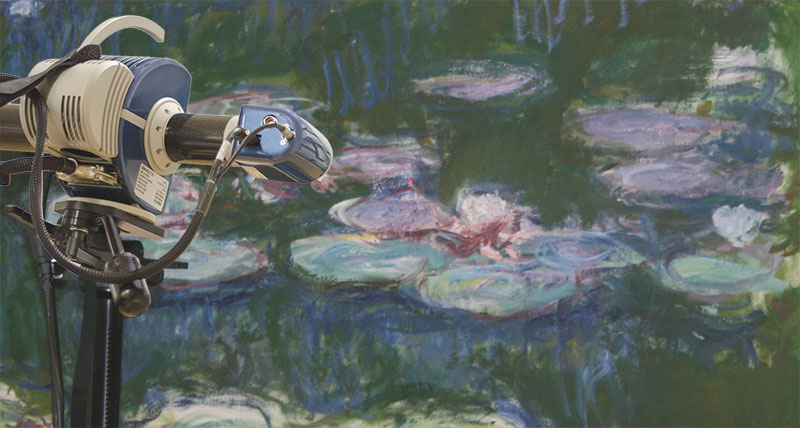
State-of-the-art scanning technology meets world famous painting: Three-dimensional data constitutes the ideal basis for the documentation of delicate paintings and allows for far more detailed studies than using the original paintings. In contrast to the often very time consuming actual creation of a painting, the AICON SmartScan captures the artwork swiftly and easily, thereby ensuring the exact correspondence of the 3D coordinates with their colour information by simultaneously capturing the 3D data with their respective colour texture.
Objective and measuring object
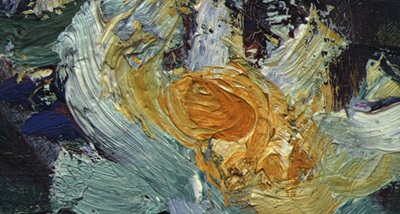 In February 2008, the Kunstmuseum Winterthur (Switzerland) commissioned the three-dimensional capture of Claude Monet’s “Water Lilies” (oil on canvas, 1916). Paintings are primarily perceived as flat objects by the viewer, with their colour scheme being the most relevant source of information. In most cases, however, a painting features a more or less pronounced three-dimensional relief, which even in the millimetre range conveys valuable information about the artist’s creative style. Therefore, when it comes to the documentation of paintings, experts go beyond the use of conventional 2D techniques and instead chose the option of 3D digitisation with a white light scanner.
In February 2008, the Kunstmuseum Winterthur (Switzerland) commissioned the three-dimensional capture of Claude Monet’s “Water Lilies” (oil on canvas, 1916). Paintings are primarily perceived as flat objects by the viewer, with their colour scheme being the most relevant source of information. In most cases, however, a painting features a more or less pronounced three-dimensional relief, which even in the millimetre range conveys valuable information about the artist’s creative style. Therefore, when it comes to the documentation of paintings, experts go beyond the use of conventional 2D techniques and instead chose the option of 3D digitisation with a white light scanner.
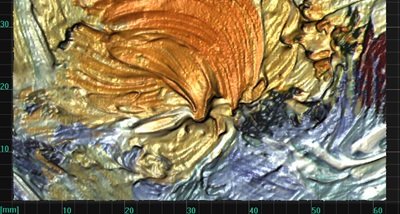 In addition to examining the individual characteristics of Monet’s painting technique, the 3D data also allows for conclusions about the current condition of the painting as well as possible damage. For an in-depth analysis of the artwork, the colour texture of the surface must also be captured and the scanning procedure needs to be conducted with utmost care and without radiation (neither UV nor heat). Using a contact-free scanning technology suitable for even the most delicate objects, the AICON SmartScan perfectly fulfils these requirements. It can be used problem free in the typical ambient conditions of a museum environment, allowing the painting to remain in its frame at the exhibition.
In addition to examining the individual characteristics of Monet’s painting technique, the 3D data also allows for conclusions about the current condition of the painting as well as possible damage. For an in-depth analysis of the artwork, the colour texture of the surface must also be captured and the scanning procedure needs to be conducted with utmost care and without radiation (neither UV nor heat). Using a contact-free scanning technology suitable for even the most delicate objects, the AICON SmartScan perfectly fulfils these requirements. It can be used problem free in the typical ambient conditions of a museum environment, allowing the painting to remain in its frame at the exhibition.
Measuring system and setup
Being able not only to generate high-resolution, precise 3D models but also to capture the true colour textures of the object surface, the AICON SmartScan is specifically designed for the demanding requirements in connection with the data acquisition of works of art and objects of cultural heritage. The 3D scanner consists of a sensor base mounted onto a tripod and fitted with a projector unit and two colour cameras (here: 5 megapixels), a calibration plate and a control unit. The measuring field is configured individually, i.e. depending on the size of the painting and the desired resolution of the 3D data.
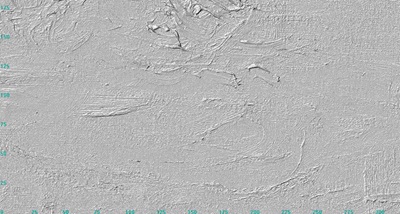 Thanks to the “Texture Mapping” module developed specifically for scanning projects in the fields of arts and cultural heritage, the further processing with the AICON software OptoCat allows for high-resolution images of the object surface to be projected onto their 3D data with sub-pixel accuracy, thus displaying the scanned object in a higher resolution, clearer contrast and improved colour representation. The Texture Mapping can be executed with the internal images of the 3D scanner as well as using images taken with an external camera, whereby external digital data offers more flexibility regarding texture acquisition, pixel resolution, professional illumination, and raw data processing with colour management. In addition, the 3D data of a monochrome sensor can be complemented with colour images or multi-spectral data (UV, IR, etc.).
Thanks to the “Texture Mapping” module developed specifically for scanning projects in the fields of arts and cultural heritage, the further processing with the AICON software OptoCat allows for high-resolution images of the object surface to be projected onto their 3D data with sub-pixel accuracy, thus displaying the scanned object in a higher resolution, clearer contrast and improved colour representation. The Texture Mapping can be executed with the internal images of the 3D scanner as well as using images taken with an external camera, whereby external digital data offers more flexibility regarding texture acquisition, pixel resolution, professional illumination, and raw data processing with colour management. In addition, the 3D data of a monochrome sensor can be complemented with colour images or multi-spectral data (UV, IR, etc.).
Workflow
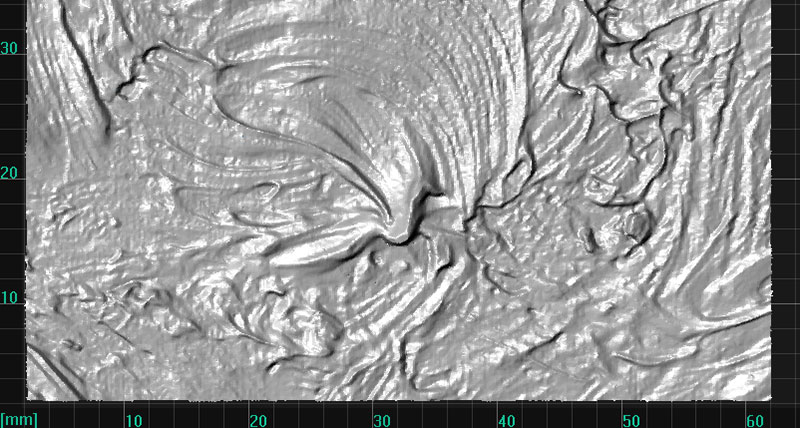 Depending on the selected measuring field, approximately 30-150 scans are taken of the entire “Water Lilies” painting. The individual scans are then merged with the OptoCat software and post processed. The performance spectrum of the software program provides all necessary functions for a complete 3D digitisation, such as merging individual scans into a polygon mesh and 2.5D-processing with the OptoCat “Painting” module. In addition, the software offers further evaluation and export functions such as the calculation of cross sections, data reduction or compression, several filter functions and the filling of holes. Using the module “Texture Mapping”, the internal images of the 3D scanner as well as other images taken with an external camera can be projected onto the 3D data.
Depending on the selected measuring field, approximately 30-150 scans are taken of the entire “Water Lilies” painting. The individual scans are then merged with the OptoCat software and post processed. The performance spectrum of the software program provides all necessary functions for a complete 3D digitisation, such as merging individual scans into a polygon mesh and 2.5D-processing with the OptoCat “Painting” module. In addition, the software offers further evaluation and export functions such as the calculation of cross sections, data reduction or compression, several filter functions and the filling of holes. Using the module “Texture Mapping”, the internal images of the 3D scanner as well as other images taken with an external camera can be projected onto the 3D data.
The captured 3D data of the painting is visualised in a shaded form (optional with overlapping texture or colour information) and saved in standard file formats such as STL or PLY. Thanks to the “Texture Mapping” module (available from version 2013R2), it is also possible to save geometric and image data together in the OBJ format.
Conclusion
 The considerate digitisation method with the AICON SmartScan is perfectly suited for the fast and detailed capture of objects of art such as Monet’s “Water Lilies”. The high-resolution 3D scanner allows for the analysis of even the smallest deviations: at a spatial resolution of approximately 50-100 µm, a height profile can be generated even in seemingly flat surfaces of paintings or frescos.
The considerate digitisation method with the AICON SmartScan is perfectly suited for the fast and detailed capture of objects of art such as Monet’s “Water Lilies”. The high-resolution 3D scanner allows for the analysis of even the smallest deviations: at a spatial resolution of approximately 50-100 µm, a height profile can be generated even in seemingly flat surfaces of paintings or frescos.
In addition to the colour scheme, the three-dimensional relief constitutes an essential contribution to the overall character of the painting and allows for additional studies about Claude Monet’s individual artistic style and brush work. It is the combination of 3D model and texture mapping which results in the unique fingerprint of an artwork.
Additionally, the 3D models generated from the scan data can be further utilized in many ways, such as:
- Digital documentation and archiving
- Quantitative capture of the current condition, in particular of damages
- Virtual reconstruction
- Virtual presentation in the museum or on the internet
- Creation of true to scale copies and replicas (e.g. using 3D printing or rapid prototyping)